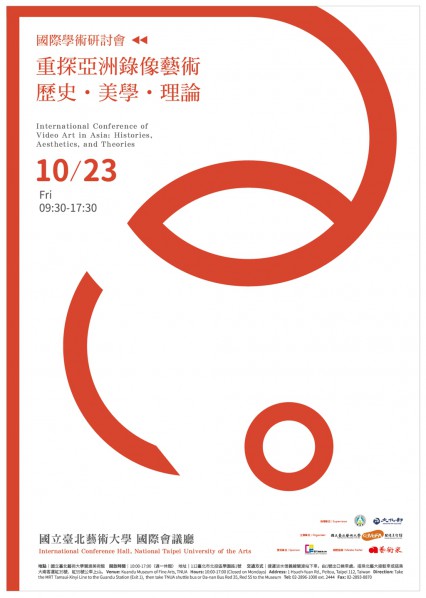
Abstract of Symposium
Video art emerged out of Occidentals’ practice in the 1950s and the 1960s. There is a world of difference between the characteristics of the newly emerged video art and those of previous image media. The traditional forms of moving images were subverted by the immediacy and unique image vocabulary that video art performs and employs in recording and broadcasting. Asian artists have ridden on the wave of this new image art since its pioneering stage. Korean artist Nam June Paik was undoubtedly the one who enjoyed the greatest reputation among them. In the post-war era between the 1960s and 1980s, Japanese artists, by virtue of their video artworks, also played a prominent role in many Western grand exhibitions on visual art, among which the Paris Biennale was the climax.
By way of comparison, the other countries in East Asia and Southeast Asia are latecomers in the field of video art. Due to the limitations on software, hardware, and knowledge system, it was not until the 1980s that the video art in these countries ushered in the initial stage. As an example, the verified surviving artworks and documents displayed in the exhibition REWIND: Taiwan Video Art in 1980s-90s held at Kuandu Museum of Fine Arts has clearly indicated that the development of Taiwan’s video art began in 1983 with the first batch of video artworks created by Taiwanese artists. Some artists did not devote themselves to video art until they studied abroad and gained new knowledge of this field. Others finished their maiden video artworks with the assistance of new knowledge offered by their professors who studied abroad and returned to Taiwan, along with the establishment of new art museums and the introduction of art magazines. In terms of form and genre, these video artworks created by Taiwanese artists in the 1980s not only resonated powerfully with the development of video art in the Occident, but also embodied the local contexts and thoughts that are simultaneously unique and profound.
Based on the genealogy of works and associated archives exhibited in REWIND: Taiwan Video Art in 1980s-90s, Kuandu Museum of Fine Arts attempts to systematically explore the development of video art in Asian countries since the 1960s in terms of aesthetics, technology, and theory. To achieve this goal, Kuandu Museum of Fine Arts organizes the International Conference on Video Art in Asia: Histories, Aesthetics and Theories, treating it as a congenial platform for experts and scholars from many Asian countries such as China, Japan, Malaysia, Singapore, South Korea, Taiwan, and Vietnam to exchange their diverse observations and experiences regarding video art, thereby establishing the cornerstone for constructive dialogues among Asian countries.
The themes to be addressed in this conference include:
1. The Contemporaneity of Video Art: The Transformation from Occidental Experiences to Asian Contexts
2. The Development of Video Art: The Process from the Introduction of New Knowledge to the Initiation of Local Creation
3. The Heterogeneous Forms of Video Art: From the Counterpoints of Aesthetic Frameworks to the Formulation of New Concepts.
4. The New Techniques of Video Art: From Artists’ Practices to the Birth of Curatorial Themes
5. The Methodology of Video Art: From the Appropriation of Theoretical Concepts to the Refinement of Local Discourses
About the conference
DATE: October 23 (FRI), 2015 10:10-17:30
Venue: International Conference Hall, National Taipei University of the Arts
Languages: Mandarin Chinese-English simultaneous interpreting
Agenda
09:40-10:10 / Registration
10:10-10:20 / Opening Welcome
10:20-11:45 / Session 1
Formation and Immateriality: Video Arts in Japan and Korea, 1980s and 1990s
Speakers:
SUMITOMO Fumihiko (Curator, Curator of Aichi Triennale 2013, Director of Arts Maebashi, Japan)
SUH Jinsuk (Curator, Director of Nam June Paik Art Center, Gyeonggi-do, Korea)
Moderator:
Jo HSIAO (Curator, Researcher of Taipei Fine Arts Museum)
11:45-13:00 / Lunch Break
13:00-15:00 / Session 2
Individual, Transformation, New Era: Video Arts in Southeast Asia and China after 1990s
Speakers:
HSU Fang Tze (Curator, Co-curator of Taiwan International Video Art Exhibition 2016)
NGUYEN Nhu Huy (Curator, Founder of Zero Station, Ho Chi Minh City, Vietnam)
DONG Bing Feng (Curator, Artistic Director of OCAT Institute, Beijing, China)
Moderator:
GUO Jau Lan (Independent Curator)
15:20-16:45 / Session 3
Experimental, New Materials, New Concepts: Video Arts of Taiwan, 1983-1999
Speakers:
SING Song Yong (Curator of Re-Wind, Associate Professor, Graduate Institute of Animation and Film Art, Tainan National University of the Arts, Taiwan)
WANG Po Wei (Researcher of Taipei Fine Arts Museum, Taiwan)
Moderator:
GONG Jow Jiun (Associate Professor, Doctoral Program in Art Creation and Theory, Tainan National University of the Arts, Taiwan)
17:00-17:30 / Panel Discussion
CHU Teh I (Director, Kuandu Museum of Fine Arts, Taipei National University of the Arts)
Jo HSIAO (Curator, Researcher of Taipei Fine Arts Museum)
GUO Jau Lan (Independent Curator)
GONG Jow Jiun (Associate Professor, Doctoral Program in Art Creation and Theory, Tainan National University of the Arts, Taiwan)
All Speakers
Courtesy of Kuandu Museum of Fine Arts, for further information please visit www.kdmofa.tnua.edu.tw.




























